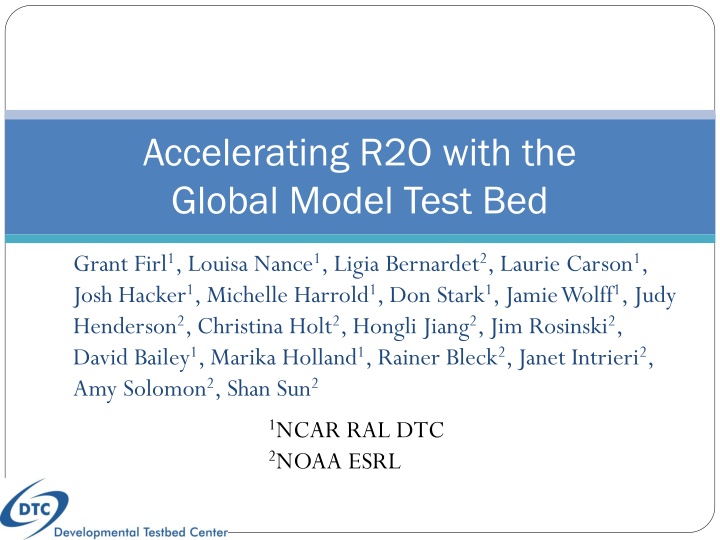
Accelerating R2O with the Global Model Test Bed and NGGPS Overview
This content discusses the initiatives Accelerating R2O and NGGPS which aim to enhance forecast guidance systems utilizing the Global Model Test Bed. It covers the development, testing, and selection of components for the Next Generation Global Prediction System, along with the role of the Common Community Physics Package.
Download Presentation

Please find below an Image/Link to download the presentation.
The content on the website is provided AS IS for your information and personal use only. It may not be sold, licensed, or shared on other websites without obtaining consent from the author. If you encounter any issues during the download, it is possible that the publisher has removed the file from their server.
You are allowed to download the files provided on this website for personal or commercial use, subject to the condition that they are used lawfully. All files are the property of their respective owners.
The content on the website is provided AS IS for your information and personal use only. It may not be sold, licensed, or shared on other websites without obtaining consent from the author.
E N D
Presentation Transcript
Accelerating R2O with the Global Model Test Bed Grant Firl1, Louisa Nance1, Ligia Bernardet2, Laurie Carson1, Josh Hacker1, Michelle Harrold1, Don Stark1, Jamie Wolff1, Judy Henderson2, Christina Holt2, Hongli Jiang2, Jim Rosinski2, David Bailey1, Marika Holland1, Rainer Bleck2, Janet Intrieri2, Amy Solomon2, Shan Sun2 1NCAR RAL DTC 2NOAA ESRL
Next Generation Global Prediction System NGGPS is the foundation for the operating forecast guidance system for the next several decades. Full Earth System Model (using NEMS) Unified and community-contributed Provide forecasts from 2-30 days + seasonal Utilize latest HPC 2
GMTB Overview Primarily funded through the NWS as part of NGGPS Liaison between community and operations for NGGPS development Developmental testing of novel NGGPS components 1. Facilitate and perform evaluation of research innovations for operations 2. 3. Community code mgmt. Provide infrastructure for community to interact with NGGPS code Provide support for NGGPS code to external developers 4. 3
GMTB First Year Focus Liaison between community and operations for NGGPS development Developmental testing of novel NGGPS components 1. Recommend selection of sea ice model for NGGPS 2. Develop and initialize a Common Community Physics Package (CCPP) 3. Document and support a new Interoperable Physics Driver for use with the CCPP 4
NGGPS Sea Ice Model Selection NGGPS needs a baseline sea ice model GMTB is providing guidance for the selection Selection Criteria Baseline Testing Recommendation to NOAA EMC Sea Ice Modeling Workshop in Boulder, February 2016 Includes candidate sea ice model groups Input from community on selection criteria; finalize criteria Solicit recommendations on selection process Input from workshop used to conduct testing leading to final recommendation 5
Common Community Physics Package NGGPS will be used for a broad range of forecast applications (2-day forecast seasonal) Although single scale-aware physics suite is the goal, initial NGGPS will use more traditional physics Multiple physics suites tuned for specific forecast application will be part of common package (suite = codes + parameter set + order) Physics parameterizations will need to modularized and standardized to fit within NGGPS CCPP 6
Common Community Physics Package A library of dycore-agnostic physics parameterizations Can be combined as suites (GFS suite, HRRR suite, etc.) Multiple parameterizations of each category (radiation, microphysics, PBL, etc.) New and experimental suites Parameterizations only interface with Interoperable Physics Driver and conform to modern coding standards Parameterization I/O is standardized and flows through driver Curated by a Physics Review Committee with representation from NOAA EMC, NCAR DTC, research community 7
Common Community Physics Package Initially, CCPP consists of current GFS physics Documented and refactored to work with IPD Modular parameterizations with standardized interfaces (to driver and other parameterizations) Eventually, CCPP will have a limited collection of GMTB- supported physics suites CCPP infrastructure will facilitate R2O by standardizing I/O, error handling, driver interface Allows for physics developers to plan/code for plug-and-play with NGGPS 8
Interoperable Physics Driver Goals Flexible code to interface potentially many dycores with all physics parameterizations in the CCPP, either individually or as suites Standard passthrough for physics parameterization output and errors Facilitates community involvement by providing standard interface to operational dycores DTC role Identify driver requirements Document and provide community support for driver use 10
CCPP Test Harness Uniformity of testing Integration within NOAA EMC s setup GMTB focuses on lower levels Supports testing by physics developers 11
CCPP Test Harness Testbed for physics innovations Framework Cases: initialization data, forcing, observations for evaluation Source codes, scripts, diagnostic and verification tools Using test harness Upgrades to existing and new developments from community Collaboration among physics developers, DTC, NOAA EMC 12
GMTB Summary Mission 1. Developmental testing of novel NGGPS components 2. Serve as liaison between research community and operational centers regarding NGGPS development Initial year activities 1. Recommend sea ice model for initial NGGPS 2. Develop a CCPP 3. Document and support a driver for use with CCPP 13
Thank You Accelerating R2O with the Global Model Test Bed Grant Firl1, Louisa Nance1, Ligia Bernardet2, Laurie Carson1, Josh Hacker1, Michelle Harrold1, Don Stark1, Jamie Wolff1, Judy Henderson2, Christina Holt2, Hongli Jiang2, Jim Rosinski2, David Bailey1, Marika Holland1, Rainer Bleck2, Janet Intrieri2, Amy Solomon2, Shan Sun2 1NCAR RAL DTC 2NOAA ESRL
